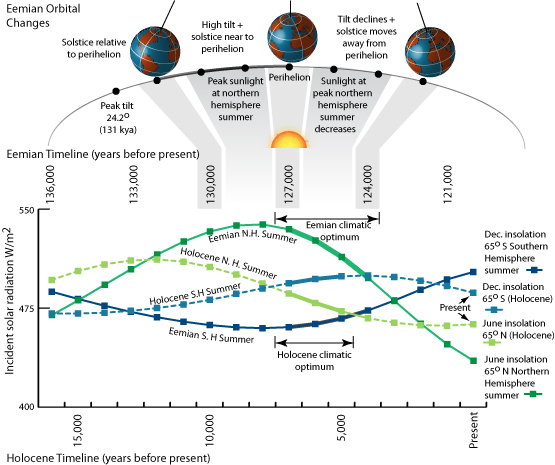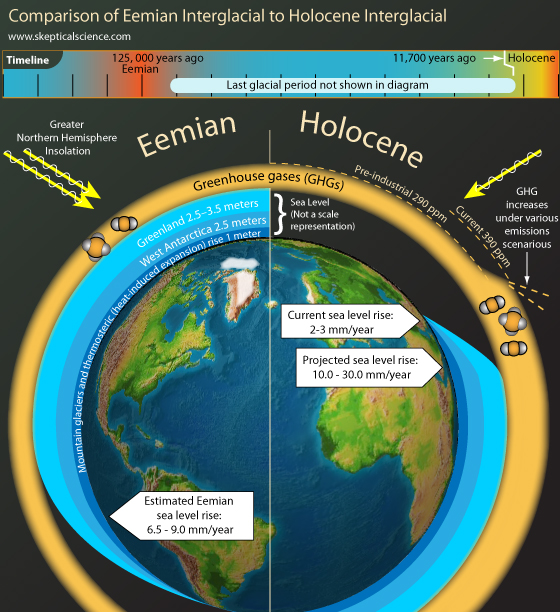
Note: This is the fifth and final article of a five-part series on what we can learn from the Last Interglacial time period. Understanding this period may provide clues on how the environment may respond to similar conditions in the future. In the first post, we described the conditions that exisited during the Last Interglacial. In the second post, we looked at the key factors for making it a warm period. In the third post, we looked at how sea-levels rose as a result of melting ice-sheets. In the fourth post, we examined how the Last Interglacial oceans influenced the climate. In this final post, we summarise what we've learnt and conclude the discussion on the value of the Last Interglacial for helping us predict the future.
Comparing the influences on the Last Interglacial climate with those assumed in future climate projections is problematic owing to fundamental differences, especially orbital forcing, seasonal warming, and greenhouse gas concentrations. Palaeoclimate studies show that differences in the manner in which the Earth orbited the Sun during the Last Interglacial are sufficient to explain the higher temperatures over most parts of the Northern Hemisphere, particularly due to greater axial tilt and eccentricity compared with the present day orbital configuration. This greater axial tilt provided stronger insolation (solar heating) at high latitudes and weaker insolation at low latitudes. Perihelion, when the Earth is nearest the Sun, occurred during summer in the Northern Hemisphere, which amplified seasonal insolation, while perihelion occurs in winter during the present day. Figure 1 shows a comparison of Eemian and Holocene summer insolation, which highlights the key differences between then and now. If you click on Figure 1, it will show an animation to make this easier to visualise. Peak insolation from orbital forcing will be significantly lower over the next century than what the Earth received during the peak warm period around 126,000 years ago.
The Last Interglacial climate was characterised by strong seasonality with warmer summers and cooler winters, which does not compare with the outcomes of predicted future greenhouse warming where both warmer winters and summers are expected. Warmer winters may encourage the poleward spread of coniferous forests that would accelerate snow and ice melting during the Arctic summer.
Atmospheric CO2 varied between 250 to 300 ppmv. Atmospheric CO2 during the Last Interglacial was comparable to the pre-industrial Holocene and reasonably stable, which prevents the period being a good analogue for future climate. Today, atmospheric CO2 is much higher; ~390 ppm and increasing by ~2 ppm yr-1, giving a higher contribution to radiative forcing than would be expected during the Last Interglacial.
Predictions of future sea-level rise and reduction in volume of ice sheets are consistent with what the evidence indicates during the Last Interglacial. The IPCC AR4 report suggests a complete disappearance of the Greenland Ice Sheet during the Last Interglacial, providing a contribution of up to 2 to 4 m of sea-level rise, while Cuffey and Marshall (2000) estimate that the Greenland Ice Sheet melt contributed towards 4 to 5.5 m of sea-level rise. According to Allison et al. (2009), as much as 2 m of sea-level rise could happen by 2100 with predicted global mean warming of +2.0oC. However, it should be recognised that the equivalent warming during the Last Interglacial occurred over thousands of years and the thermal response of ice and oceans would be much slower. Field et al. (1994) and Seidenkrantz & Knudsen (1997) raise the possibility that predicted higher sea-level could cause warming of the North Sea and cause warmer temperatures in northern Europe due to warm water from the North Atlantic Drift to pass through the English Channel into the North Sea and opening sea-ways between the North and Baltic Seas. A stronger North Atlantic Drift might also increase the flow of warm water into the North Sea past northern Britain. However, this may be mitigated if the present isostatic rebound of the northwest European crust outpaces greenhouse warming induced sea-level rise (Burman & Passe, 2008).
The dynamics of the Atlantic Meridional Overturning Circulation (AMOC) and its influence on climate is hotly debated and evidence for its behaviour during the Last Interglacial may have potential in determining how ocean circulation and related climatic effects may alter in a future warming world. Most models that investigate increasing greenhouse gas scenarios predict that the AMOC will slow down as a result of such forcing (Driesschaert et al., 2007; Hodell et al., 2009). However, other model results suggest that anthropogenic aerosols may have delayed a greenhouse gas induced weakening of the AMOC by reflecting inbound solar radiation and partially offsetting greenhouse gas warming (Vellinga et al., 2008). Crowley and Kim (1992) and Lisiecki et al. (2008) show that the AMOC may be sensitive to different orbital parameters, such as maxima in obliquity and precession, and link orbital eccentricity to North Atlantic Deep Water production.
Some climate models of the Last Interglacial suggest that a high-index state of the North Atlantic Oscillation (NAO) was favoured due to the configuration of orbital parameters. Less vigorous ocean circulation in the North Atlantic has been associated with positive phases of NAO. If peak summer insolation during the early Last Interglacial favoured a persistent positive NAO, this may have contributed to the slow circulation from 128 to 124 ka. (Hodell et al., 2009), as well as AMOC anomalies due to heat flux and surface wind stress variability (Vellinga et al., 2008). With a significantly different orbital configuration over the coming centuries it cannot be expected that the behaviour of the NAO and AMOC would be similar to that during the Last Interglacial.
Comparison of the behaviour of the El Nino Southern Oscillation (ENSO) during the Last Interglacial and the recent past indicate that it may be changing in response to increased greenhouse gasses. Hughen et al. (1999) suggests a robust ENSO variability that matches ENSO behaviour in the recent past. The similarity appears to diverge from observations of ENSO variability since the 1970's indicating that ENSO since then is anomalous to natural variability i.e. ENSO may be relatively stable during interglacials. El Nino events have become more frequent since the 1970's compared with the warmer Last Interglacial, which prompts the hypothesis that the higher frequency may be related to the rate of greenhouse gas induced warming rather than warmer mean conditions.

The difference in greenhouse gas concentration combined with significantly different orbital parameters and seasonal insolation may limit the validity of using the Last Interglacial as an analogue for predicted future changes to the climate system. The proxy coverage of the period in the Southern Hemisphere and large parts of the Northern Hemisphere is poor, giving a bias towards Europe and the North Atlantic region. The value of the Last Interglacial in aiding prediction of future climate change is restricted to mainly Europe and the North Atlantic. To improve our ability to predict the potential impacts of future climate change it is essential that the search for proxy data in new locations with a more comprehensive geographical spread are sought out in order to get a more global picture of ancient climate with better resolution.
Acknowledging the problems and benefits of using the Last Interglacial as an analogue for a future warming climate begs the question of whether there may be a more suitable analogue in the past. Loutre and Berger (2002) suggest that Marine Isotope Stage 11 (MIS 11) from 405 to 340 ka would make a better analogue for future climate than the Last Interglacial, due to it being a warmer interglacial period, but with an orbital insolation signal that correlates closely with the recent past and future, giving a much better comparison of orbital forcing. MIS 11 also appears to have been possibly the warmest and longest interglacial of the past 5 million years and had an extended period with little or no continental ice, which is projected to occur under some future global warming scenarios.
Because the observed and predicted rate of increase in greenhouse gas concentrations and global warming is faster than seems to have happened during the Last Interglacial may mean that we are heading into uncertain territory.
I would like to acknowledge the enormous contribution of my fellow SkS contributor, jg, towards the production of this series. Thank you, jg!
Posted by Steve Brown on Thursday, 17 November, 2011
 |
The Skeptical Science website by Skeptical Science is licensed under a Creative Commons Attribution 3.0 Unported License. |